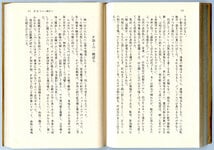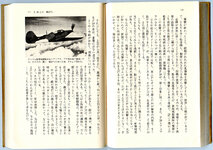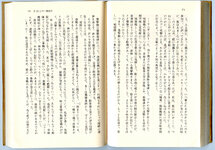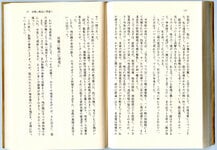The following story was introduced by a former Ki-21 pilot Yoshiaki Kubo in his 1984 book "九七重爆隊空戦記 (Air Battle Story of a Type 97 Heavy Bomber Unit)"
Duel in the sky with a P-39
Setting aside our desire and environment in the front, the Battle of New Guinea was getting fiercer and fiercer in 1943 when I was there.
After IJN failed transport to Lae, another fleet composed of 6 transport ships escorted by 5 destroyers was to transport the personnels and supplies to Hansa in New Guinea and our IJA 14th Sentai which was composed of Ki-21 bombers was ordered to destroy enemy aircraft on the ground there in advance. So,on March 9, we headed for Wau to attack.
In the volcanic ash rising in the airfield of Kokopo near Rabaul, our 27 bombers took off and joined IJN's escorting Zero fighters in the air to advance as an orderly large formation. Fortunately we did not enounter any enemy fighters on the way and were able to take a detour from the mountain side to attack the Wau airfield. We destroyed several large planes parking on the ground and our all planes returned to Kokopo and Rabaul safely though failed to take ground photos to show results.
On the following 11th day, we attacked the Buna airfield. When we came over the target, I was surprised to discover some more new airfields under construction in spite of such a short period after the enemy troops occupied there. The number of escorting Zeros on the day was about 40 including a unit from the aircraft carrier Zuiho. At the time, we had not a few chances to work with Zeros and were still confident that we wouldn't lose the battle easily.
About 30 enemy fighters like P-38, P-39 and P-40 were observed on the ground. They immediately flew up and began combat with our Zeros soon.
When we finished dropping bombs, enemy fighters now began to attack us bombers. It seemed that our several planes had hits. I saw a large hole in the fuselage of Matsuura's plane which was flying next to me. However, all planes were able to come back to the base anyhow. 4 bombers were damaged. 2 of them were wrecked with the undercarriage failure when landed. Although several crews were injured, our escorting Zeros' best fight kept the damage to the minimum. Instead, our bombers and fighters destroyed more than 30 enemy planes on the ground and in the air. The navy lost 1 Zero and 2 were damaged.
I saw the P-38 for the first time in this mission. Its twin-boomed shape impressed me so much. Also, a bold P-39 Airacobra looked crazy to me.
No sooner it climbed sharply a thousand meters far ahead of us than it attacked our formation from directly above passing through inside our formation which was tightly blocked. When the P-39 confirmed no effect, it boosted acceleration to move ahead of us again and repeated the attack from above in the same way.
To shut his exit, I immediately drifted my plane toward the direction he tried to escape through. The P-39 was so distracted by finding exit that his shooting accuracy dropped. On the other hand, it was not easy for our gunner to grind the gun directly above to shoot the target.
This was nothing dramatic but a test of endurance because our weak point was the attack from the front bottom, not necessarily from the high above but, knowing it or not, the crazy P-39 repeated the hit-and-run tactics many times. Though it was not my business but the gravity for the pilot would be about 6G to pull the nose up. He could have suffered G a lot. Even so, appearance of the P-39 which dived from the high sky showing white streaks from the wing tips was powerful, which was never expected for a bomber. The attack continued until our Zeros cut in.
When we took the way home, a strange thing happened. A fighter which looked enemy was approaching to my plane swinging wings. It looked the P-39 I fought. Keeping the flight direction parallel and the speed same, it was getting closer and closer to my plane which flew outermost formation. As our escorting Zeros were flying a little far away, it seemed that they did not think it was enemy.
I indicated my gunners not to shoot and watched it coming closer even more rapidly. We would not be shot unless the P-39 pointed its nose at us while we could shoot it at any time but everything looked totally weird. My gunners kept alert.
I could see the enemy pilot's face at last. His white helmet was like a slightly inflated rugby ball. He looked trying to tell me something.
I was convinced that he was the one I fought earlier and instinctively understood that he was telling me that I avoided his attack well, so I raised my hand to show my respect to him.
Then, he quickly turned over his wing and flew away. I did not know if it should be called Yankee spirit but I liked his courage to approach taking risk of being shot. At the same time, I kept it in my mind well that the enemy was tougher than I expected.
Since that time, not a few our planes were ambushed and shot by the enemy but I always tried to find the enemy first. So, I was confident that I would be one of the best escapers in the sky.
About this story, LTJG Tsutomu Iwai of the 601-ku from "Zuiho" fighter corps who escorted us during this Buna attack also left his testimony seen from a different angle. Let me introduce it here.
"On March 11, 1943, we flew to Buna escorting about 40 army heavy bombers. We fighters had three missions at the time, the protection of our base or fleet, the air control and the escort of bombers during joint mission.
Fighters for the air control mission were allowed to fight freely maximizing its performance as a fighter but that was not the case for the escorting fighters. The first role was to protect the bombers chasing down the enemy. Even though there was an enemy fighter that could be shot down, you did not chase it if you got away from the bombers that should be protected.
In other words, escorting was the most dangerous and painful mission for the fighters because they were asked to become a shield to make the bombers completely produce good results. This was the most difficult task as a fighter.
When bombers enter the bombing course and the commander bomber dropped the bombs, the row planes followed it to drop the bombs at the same time. When finished, they lowered the altitude to escape from the enemy airspace with full throttle.
In such a mission, bombers did not turn 180 degrees to come home after bombing because they turned in advance before entering the bombing course. This is to save time staying over the enemy airspace as staying longer was disadvantageous in every respect. "Enter straight to the target and keep flying as it is to home." was it.
Also, after bombing, bombers flew as close as possible each other as though overlapping wings forming a mass. In this way, no matter what direction the enemy fighter might attack from, there would be no blind spot for the gunners. If it was only one or two fighters which might attempt attack, they had few chances to break the mass.
Our altitude on that day was 7,000 meters. As many cumulonimbus clouds were observed here and there, visibility was poor making it difficult to watch. Through these clouds, I saw an enemy fighter diving onto the tail of our commander's bomber and more followed.
I (Iwai) and my fellows rushed toward there to start air combats here and there. I was engaged in a combat with 2 P-39s. At the altitude of 8,000 meters, I caught the back of them who tried to escape downward in tandem. I fired at a distance of 30 meters but my 20mm cannons were frozen and no bullets came out. Only 7.7 mm shells came out with a modest sound.
I knew that I should not leave bombers as an escort fighter but could not resist chasing them because there seemed a great chance to shoot them down. Then, the enemy's first plane suddenly zoomed to take the attacking position. Damn! I gave up the 2nd one and chased the 1st one but at the high altitude the enemy fighter had better performances than mine.
The enemy climbed up leaving me far behind and turned back to give attack from high above. I was so slow and almost stalled that I had no choice but trying my best to dodge the opponent's shooting line.
I was still over Buna in the enemy's land. To my worse, all my fellows had gone home. As my opponent understood his advantageous, he tried to shoot me down with confidence at once.
Then, two my fellow planes suddenly appeared to attack my opponent from above. When the enemy saw it, he immediately dived to fly away. I thought there were no fellows anymore but Yamashita and Ohno still stayed to save me.
If there had not been help by these two men, I might have had the end of my life there. The combat was over but, as my plane was not so good as to go back to Rabaul on that day, I made a temporary landing on Tuluvu."
According to the U.S. military records, Wau was attacked by our 26 bombers and 21 fighters on March 9 but had no damage. 2 personnels were killed and 3 planes were destroyed on the ground during Buna attack on the 11th. The Allied side shot down our 9 planes but lost a P-40.
Therefore, it is said that Gen. Kenney went to Washington to appeal reinforcement of his 5th AF with the replacement of troops, improvement of nutrition, renewal of environments, replenishment and repair, etc.
It is interesting for me to compare the differences of operations and damage reports between US and Japan. I can assure that, as far as our damage is concerned, there is absolutely no mistake. Our aircraft loss on the day was only one combined bombers and fighters.
At the beginning of March, the enemy's air force in the eastern New Guinea was about 300. Also, it was thought that there were another 300 behind. We had 100 aircraft, and there were about 100 spare planes on the Turk Island.
The enemy was equipped with radar not only on ships but also on bombers and fighters, which enhanced attack effects even in the dark, but we had neither radar nor seasoned airmen for such night attacks comparable to it.
Moreover, the number of enemy planes and bases in the region was expected to double by the end of June, 1943. The difference was several times higher.
Our busy mission for attack, transportation and guidance
Our 14th Sentai achieved considerable results in the attack on March 9th and 11th, but more than that, we suffered painful damage from the enemy's night air raids.
First of all, on the night of March 11th, several B-24 bombers relentlessly attacked. All our planes were scattered to hide in bunkers but as too many bombs were dropped, our planes were unable to escape from being damaged.
Although our damage was not serious in this night, the enemy seemed knowing exactly where our bunkers were located.
End.

Duel in the sky with a P-39
Setting aside our desire and environment in the front, the Battle of New Guinea was getting fiercer and fiercer in 1943 when I was there.
After IJN failed transport to Lae, another fleet composed of 6 transport ships escorted by 5 destroyers was to transport the personnels and supplies to Hansa in New Guinea and our IJA 14th Sentai which was composed of Ki-21 bombers was ordered to destroy enemy aircraft on the ground there in advance. So,on March 9, we headed for Wau to attack.
In the volcanic ash rising in the airfield of Kokopo near Rabaul, our 27 bombers took off and joined IJN's escorting Zero fighters in the air to advance as an orderly large formation. Fortunately we did not enounter any enemy fighters on the way and were able to take a detour from the mountain side to attack the Wau airfield. We destroyed several large planes parking on the ground and our all planes returned to Kokopo and Rabaul safely though failed to take ground photos to show results.
On the following 11th day, we attacked the Buna airfield. When we came over the target, I was surprised to discover some more new airfields under construction in spite of such a short period after the enemy troops occupied there. The number of escorting Zeros on the day was about 40 including a unit from the aircraft carrier Zuiho. At the time, we had not a few chances to work with Zeros and were still confident that we wouldn't lose the battle easily.
About 30 enemy fighters like P-38, P-39 and P-40 were observed on the ground. They immediately flew up and began combat with our Zeros soon.
When we finished dropping bombs, enemy fighters now began to attack us bombers. It seemed that our several planes had hits. I saw a large hole in the fuselage of Matsuura's plane which was flying next to me. However, all planes were able to come back to the base anyhow. 4 bombers were damaged. 2 of them were wrecked with the undercarriage failure when landed. Although several crews were injured, our escorting Zeros' best fight kept the damage to the minimum. Instead, our bombers and fighters destroyed more than 30 enemy planes on the ground and in the air. The navy lost 1 Zero and 2 were damaged.
I saw the P-38 for the first time in this mission. Its twin-boomed shape impressed me so much. Also, a bold P-39 Airacobra looked crazy to me.
No sooner it climbed sharply a thousand meters far ahead of us than it attacked our formation from directly above passing through inside our formation which was tightly blocked. When the P-39 confirmed no effect, it boosted acceleration to move ahead of us again and repeated the attack from above in the same way.
To shut his exit, I immediately drifted my plane toward the direction he tried to escape through. The P-39 was so distracted by finding exit that his shooting accuracy dropped. On the other hand, it was not easy for our gunner to grind the gun directly above to shoot the target.
This was nothing dramatic but a test of endurance because our weak point was the attack from the front bottom, not necessarily from the high above but, knowing it or not, the crazy P-39 repeated the hit-and-run tactics many times. Though it was not my business but the gravity for the pilot would be about 6G to pull the nose up. He could have suffered G a lot. Even so, appearance of the P-39 which dived from the high sky showing white streaks from the wing tips was powerful, which was never expected for a bomber. The attack continued until our Zeros cut in.
When we took the way home, a strange thing happened. A fighter which looked enemy was approaching to my plane swinging wings. It looked the P-39 I fought. Keeping the flight direction parallel and the speed same, it was getting closer and closer to my plane which flew outermost formation. As our escorting Zeros were flying a little far away, it seemed that they did not think it was enemy.
I indicated my gunners not to shoot and watched it coming closer even more rapidly. We would not be shot unless the P-39 pointed its nose at us while we could shoot it at any time but everything looked totally weird. My gunners kept alert.
I could see the enemy pilot's face at last. His white helmet was like a slightly inflated rugby ball. He looked trying to tell me something.
I was convinced that he was the one I fought earlier and instinctively understood that he was telling me that I avoided his attack well, so I raised my hand to show my respect to him.
Then, he quickly turned over his wing and flew away. I did not know if it should be called Yankee spirit but I liked his courage to approach taking risk of being shot. At the same time, I kept it in my mind well that the enemy was tougher than I expected.
Since that time, not a few our planes were ambushed and shot by the enemy but I always tried to find the enemy first. So, I was confident that I would be one of the best escapers in the sky.
About this story, LTJG Tsutomu Iwai of the 601-ku from "Zuiho" fighter corps who escorted us during this Buna attack also left his testimony seen from a different angle. Let me introduce it here.
"On March 11, 1943, we flew to Buna escorting about 40 army heavy bombers. We fighters had three missions at the time, the protection of our base or fleet, the air control and the escort of bombers during joint mission.
Fighters for the air control mission were allowed to fight freely maximizing its performance as a fighter but that was not the case for the escorting fighters. The first role was to protect the bombers chasing down the enemy. Even though there was an enemy fighter that could be shot down, you did not chase it if you got away from the bombers that should be protected.
In other words, escorting was the most dangerous and painful mission for the fighters because they were asked to become a shield to make the bombers completely produce good results. This was the most difficult task as a fighter.
When bombers enter the bombing course and the commander bomber dropped the bombs, the row planes followed it to drop the bombs at the same time. When finished, they lowered the altitude to escape from the enemy airspace with full throttle.
In such a mission, bombers did not turn 180 degrees to come home after bombing because they turned in advance before entering the bombing course. This is to save time staying over the enemy airspace as staying longer was disadvantageous in every respect. "Enter straight to the target and keep flying as it is to home." was it.
Also, after bombing, bombers flew as close as possible each other as though overlapping wings forming a mass. In this way, no matter what direction the enemy fighter might attack from, there would be no blind spot for the gunners. If it was only one or two fighters which might attempt attack, they had few chances to break the mass.
Our altitude on that day was 7,000 meters. As many cumulonimbus clouds were observed here and there, visibility was poor making it difficult to watch. Through these clouds, I saw an enemy fighter diving onto the tail of our commander's bomber and more followed.
I (Iwai) and my fellows rushed toward there to start air combats here and there. I was engaged in a combat with 2 P-39s. At the altitude of 8,000 meters, I caught the back of them who tried to escape downward in tandem. I fired at a distance of 30 meters but my 20mm cannons were frozen and no bullets came out. Only 7.7 mm shells came out with a modest sound.
I knew that I should not leave bombers as an escort fighter but could not resist chasing them because there seemed a great chance to shoot them down. Then, the enemy's first plane suddenly zoomed to take the attacking position. Damn! I gave up the 2nd one and chased the 1st one but at the high altitude the enemy fighter had better performances than mine.
The enemy climbed up leaving me far behind and turned back to give attack from high above. I was so slow and almost stalled that I had no choice but trying my best to dodge the opponent's shooting line.
I was still over Buna in the enemy's land. To my worse, all my fellows had gone home. As my opponent understood his advantageous, he tried to shoot me down with confidence at once.
Then, two my fellow planes suddenly appeared to attack my opponent from above. When the enemy saw it, he immediately dived to fly away. I thought there were no fellows anymore but Yamashita and Ohno still stayed to save me.
If there had not been help by these two men, I might have had the end of my life there. The combat was over but, as my plane was not so good as to go back to Rabaul on that day, I made a temporary landing on Tuluvu."
According to the U.S. military records, Wau was attacked by our 26 bombers and 21 fighters on March 9 but had no damage. 2 personnels were killed and 3 planes were destroyed on the ground during Buna attack on the 11th. The Allied side shot down our 9 planes but lost a P-40.
Therefore, it is said that Gen. Kenney went to Washington to appeal reinforcement of his 5th AF with the replacement of troops, improvement of nutrition, renewal of environments, replenishment and repair, etc.
It is interesting for me to compare the differences of operations and damage reports between US and Japan. I can assure that, as far as our damage is concerned, there is absolutely no mistake. Our aircraft loss on the day was only one combined bombers and fighters.
At the beginning of March, the enemy's air force in the eastern New Guinea was about 300. Also, it was thought that there were another 300 behind. We had 100 aircraft, and there were about 100 spare planes on the Turk Island.
The enemy was equipped with radar not only on ships but also on bombers and fighters, which enhanced attack effects even in the dark, but we had neither radar nor seasoned airmen for such night attacks comparable to it.
Moreover, the number of enemy planes and bases in the region was expected to double by the end of June, 1943. The difference was several times higher.
Our busy mission for attack, transportation and guidance
Our 14th Sentai achieved considerable results in the attack on March 9th and 11th, but more than that, we suffered painful damage from the enemy's night air raids.
First of all, on the night of March 11th, several B-24 bombers relentlessly attacked. All our planes were scattered to hide in bunkers but as too many bombs were dropped, our planes were unable to escape from being damaged.
Although our damage was not serious in this night, the enemy seemed knowing exactly where our bunkers were located.
End.
Attachments
Last edited:




